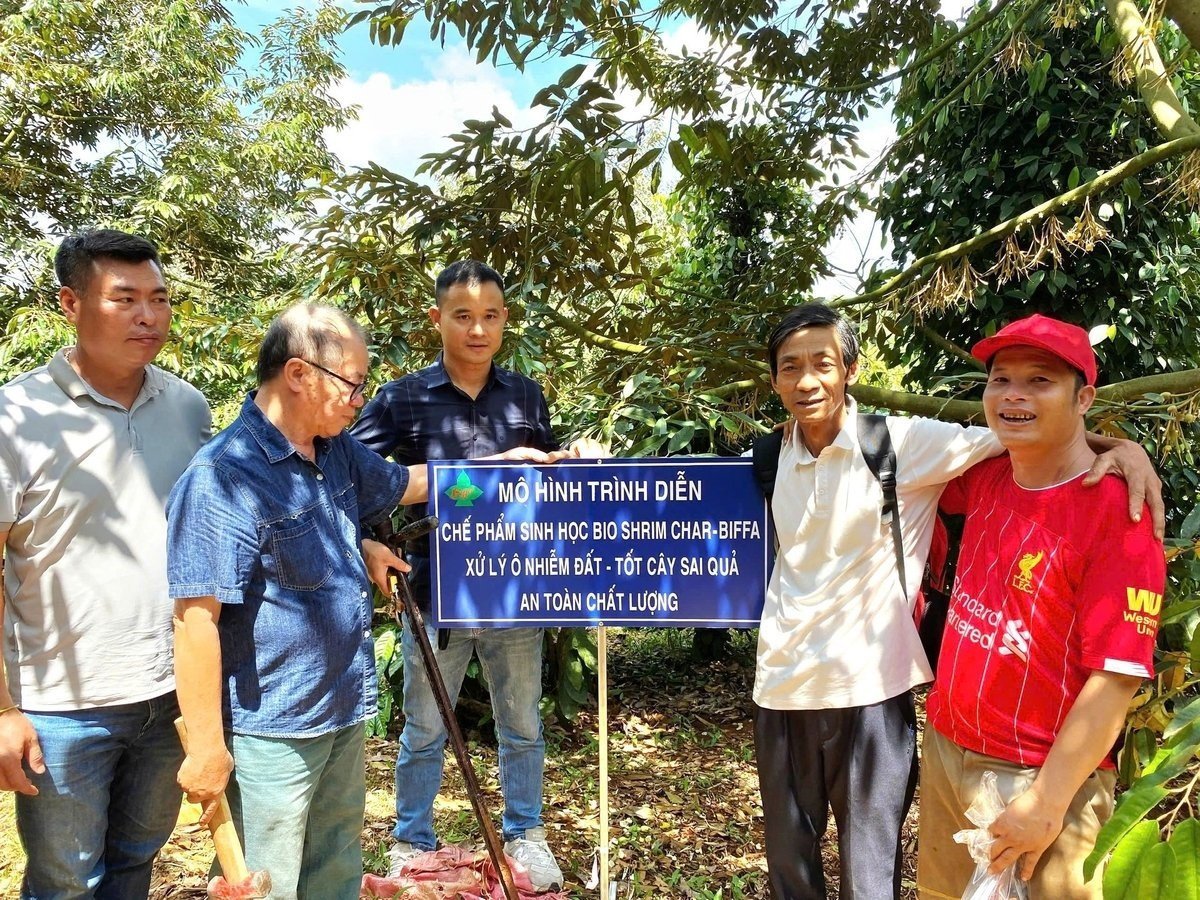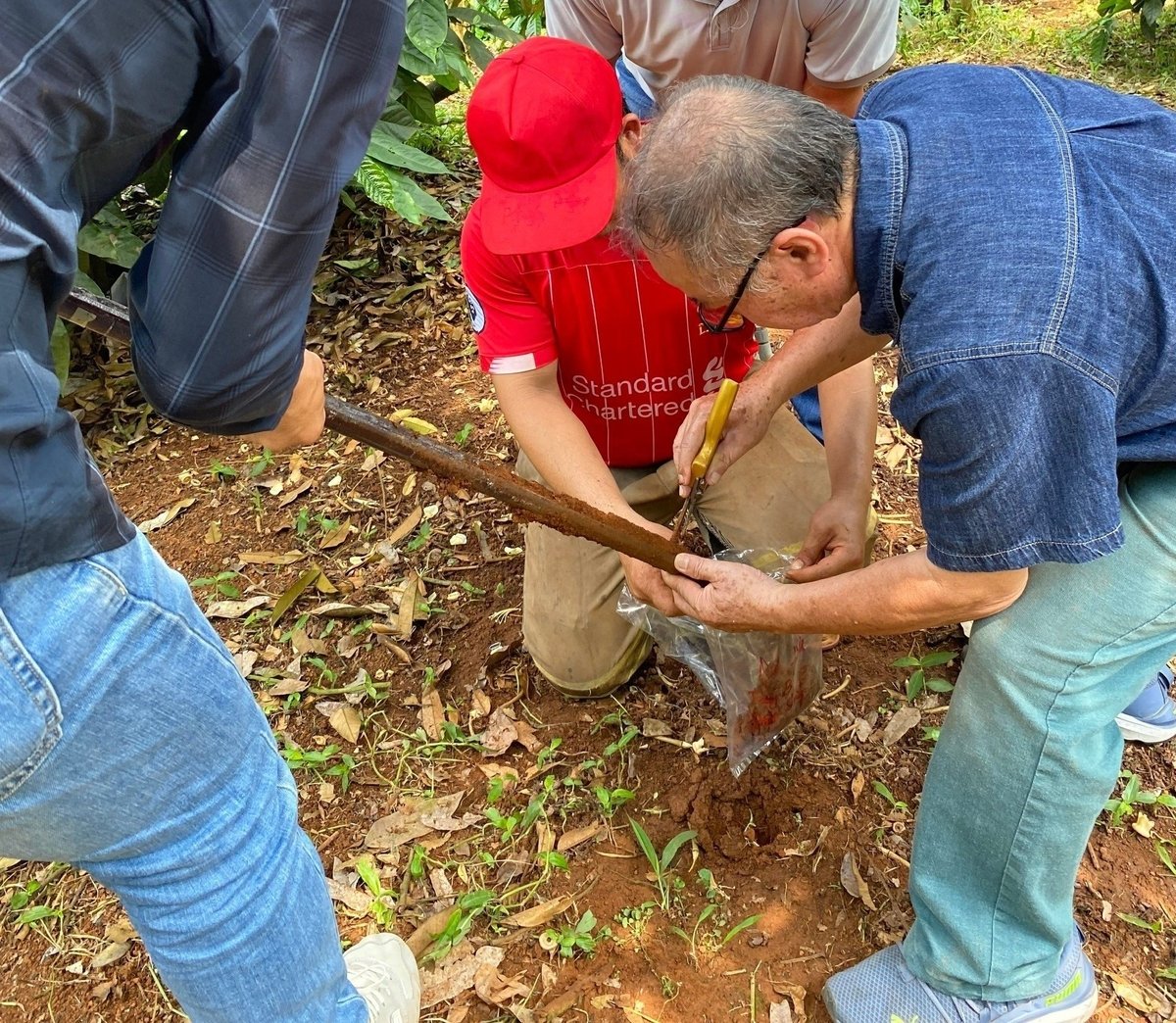May 30, 2025 | 15:10 GMT +7
May 30, 2025 | 15:10 GMT +7
Hotline: 0913.378.918
May 30, 2025 | 15:10 GMT +7
Hotline: 0913.378.918
Cadmium is a heavy metal that was once rarely found in agricultural products. However, the massive expansion of durian farming areas to seize export opportunities, along with the overuse of fertilizers, particularly DAP and phosphate fertilizers, has unintentionally reintroduced cadmium into the soil.
Dr. Nguyen Dang Nghia, an agricultural expert, warns, “When durian trees suffer from deficiencies in medium and trace elements, they will passively absorb available elements in the soil, including cadmium. If accumulated over time, this substance can infiltrate the fruit and exceed the permitted level.”

Dr. Nguyen Dang Nghia's team assists farmers in soil treatment in some key durian-growing regions in the Central Highlands. Photo: Minh Sang.
Currently, Dr. Nguyen Dang Nghia's team is experimenting with soil treatment in key durian-growing areas, including Cai Lay (Tien Giang), Dak Song, and Gia Nghia (Dak Nong). The methods being applied include using cadmium-adsorbing agents and controlling cultivation processes and fertilizer doses.
The experimental results will serve as a basis for evaluating soil improvement potential, aiming to meet safety standards, primarily technical standards required by the Chinese market, the largest consumer of Vietnamese durian today.
At Dak R’lap district (Dak Nong province), the Thien Phu–Nhan Co Durian Club is focusing on implementing the most systematic and practical soil improvement model to date. Since the regulation on testing cadmium in durian was introduced, following guidance from the Vietnam Fruits and Vegetables Association, club members have collected soil samples for analysis and have taken soil treatment steps.
Additionally, the club has gained access to advanced durian care techniques, with special attention to clean production, focusing on the stages of fertilizer and pesticide use. Mr. Nguyen Thai Binh, Club Chairman, shared, “Initially, we collected soil samples for testing to establish a control basis, then proceeded to treat the soil with biological products. About ten days later, we continued to collect soil samples for comparative testing. The results were very positive, with cadmium levels significantly reduced, reaching near-zero concentrations in many areas.”
According to Mr. Binh, Thien Phu Durian Club currently has 40 members cultivating more than 400 hectares of durian, mainly Dona and Ri6 varieties. In the initial phase, the club selected two pilot farms for soil improvement, including Mr. Nguyen Chuong’s 4.5-hectare plot and Mr. Dao Van Duc’s 3-hectare plot in Village 8, Nhan Co Commune, both of which yielded positive results.
Subsequently, the methods applied in these two pilot models were rapidly replicated, and up to now, the club’s entire durian area has undergone thorough soil treatment, achieving a “Zero Cadmium” level and achieving certification.

Many durian areas of the Thien Phu – Nhan Co Durian Club have undergone thorough soil treatment, achieving a “Zero Cadmium” level and achieving certification. Photo: Minh Sang.
Based on this foundation, the club has shifted to a biological farming model, applying NPK fertilizers at proper doses and proactively managing input sources to minimize the risk of cadmium reintroduction into the soil. The Thien Phu Club’s model is currently being studied by many localities within and outside the province and is expected to become a bright spot in Vietnam's strategy to restore confidence in its durian export industry.
According to the Plant Production and Protection Department (under the Ministry of Agriculture and Environment), to prevent direct impacts on durian fruit quality, the specialized sector has proactively conducted field surveys and assessments and coordinated with localities to develop a set of synchronous intervention measures in both the short and long term.
According to experts, the immediate priority is soil improvement to reduce the plant’s cadmium absorption. Specific measures include raising the soil’s pH using lime or appropriate amendments, applying agents that precipitate or adsorb heavy metals, and rotating crops capable of cadmium absorption as a short-term biological solution.
The functional sector also recommends that farmers temporarily switch to cultivating short-day, high-biomass crops to restore soil health and avoid formal durian farming during this sensitive phase.
In the long term, the core solution lies in changing cultivation practices, especially in the improper use of fertilizers. Specialized agencies will intensify technical training to help farmers select the right types of fertilizers and apply them at appropriate doses, thereby minimizing the accumulation of heavy metals in the soil.

Dr. Nguyen Dang Nghia (wearing glasses) instructs farmers on soil sampling for analysis. Photo: Minh Sang.
From a business perspective, Mr. Nguyen Phong Phu, Technical Director of Vina T&T Company, said, “Since early May, we have only been able to export 1-2 containers/week due to the limitation in qualified supply. Although we have implemented strict controls from the orchards to the packing facilities, the number of linked households remains too small to ensure a stable supply chain.”
According to Mr. Phu, remediating cadmium-contaminated soil cannot be immediately successful but requires a combination of biological, chemical, and advanced cultivation techniques. More importantly, prevention must start at the source, specifically fertilizers and chemicals used at the beginning of the crop. In addition, restoring a healthy soil ecosystem is very essential. Organic farming is no longer just an option; it has become a compulsory solution.

If threats like cadmium are not swiftly and thoroughly addressed, Vietnam’s durian industry will lose not only its export advantage but also the trust of the market. Photo: Minh Sang.
To tackle the issue at its root, businesses proposed the Government tighten the fertilizer and chemical control from the beginning of the crop. At the same time, they recommend accelerating soil improvement, enhancing quality monitoring of production areas, and establishing standardized raw material areas toward clean production and sustainable development.
For sustainable production, farmers must prevent and reject smuggled fertilizers, classify soil by pollution levels, and carry out mandatory improvement in areas already contaminated by heavy metals. End-of-season sample testing alone is insufficient if input is not strictly managed.
Translated by Thu Huyen
/2025/05/25/4127-3-073637_820.jpg)
(VAN) Thanks to the promotion from an FAO-implemented project, vegetable production in greenhouses in Moc Chau has seen strong development, from 1.5 hectares in 2021 to nearly 50 hectares in 2024.

(VAN) FAO has recently supported USD 140,000 to implement the project 'Risk mitigation human-animal interface risks through disease control initiatives in pig farming.'

(VAN) The People's Committee of Tra Vinh province has approved an adjustment to the investment policy for the Green Hydrogen Plant project, increasing its area to approximately 52.76 hectares.
![Reducing emissions from rice fields: [2] Farmers’ commitment to the soil](https://t.ex-cdn.com/nongnghiepmoitruong.vn/608w/files/news/2025/05/05/dsc08881jpg-nongnghiep-140632.jpg)
(VAN) Clean rice cultivation model in Thuong Tan commune, Bac Tan Uyen district, is assisting local residents in achieving sustainable agriculture by substantially reducing costs, increasing productivity, and protecting the environment.

(VAN) At the conference to disseminate Resolution No. 68, AgriS introduced its digital agricultural ecosystem and reaffirmed its commitment to accompanying the Government in promoting private sector development and sustainable agriculture.

(VAN) 'Blue Ocean - Blue Foods' initiative is designed to restore marine ecosystems and establish sustainable livelihoods for local communities by cultivating a minimum of 1,000 hectares of cottonii seaweed in the first three years.